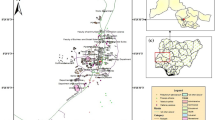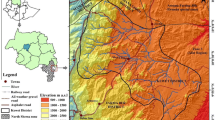Abstract
This work was undertaken to analyze nutrient contents of vegetation in an alpine meadow—Tungnath, North-West Himalaya, India. The study pertains to the uptake, transfer and release of four main macronutrients (organic carbon, total nitrogen, total potassium and total phosphorus) in grazed (exposed to extensive grazing by cattles) and ungrazed (grazing completely prohibited) communities. Mineral concentration was recorded higher for the ungrazed sites compared to the grazed sites, and maximum standing state of nutrients was found in roots. Belowground compartment (roots) contributed maximum share of mineral elements to soil. Litter nutrients release was low because of low microbial activity and continuous removal of phytomass. Observations reveal that there was very little amount of nutrient release from phytomass and vegetation in alpine are very poor source of mineral recycling. Low transfer rate of minerals from one compartment to other is adequate for greater amount of these minerals that are translocated back into the storage organs. A small proportion get removed through rain splash or through the removal of hay during grazing as relatively high release rates in ungrazed sites when compared to grazed sites was observed. This translocation can be considered as an important adaptation in alpine plants for survival during adverse environmental conditions, against all types of biotic pressures and also for regeneration in the forthcoming growing season.






Similar content being viewed by others
Abbreviations
- OC:
-
Organic carbon
- TN:
-
Total nitrogen
- TK:
-
Total potassium
- TP:
-
Total phosphorus
References
Allen SE (1974) Chemical analysis of ecological material. Blackwell, Oxford, 565 pp
Anthwal A (2006) Carbon pool and flux in the morainic and alpine ecosystem of central Himalaya. Ph.D. Thesis submitted to HNB Garhwal University, Srinagar Garhwal, Uttarakhand, India
Chapin FS (1977) Nutrient/carbon costs associated with tundra adaptation to a cold nutrient-poor environment. In: Proceedings of the circumpolar conference on Northern ecology. Natural Research Council of Canada, Ottawa, pp 1183–1194
Chapin SF (1978) Phosphate uptake and nutrient utilization by barrow tundra vegetation. In: Tieszen LL (ed) Vegetation and production ecology of an Alaskan arctic tundra. Ecological studies, vol 29. Springer, Berlin, pp 483–507
Chapin FS (1980) The mineral nutrition of wild plants. Annu Rev Ecol Syst 11:233–260
Chapin FS, Miller PC, Billings WD, Coyne PI (1980) Carbon and nutrient budgets and their control in coastal tundra. In: Brown J, Miller PC, Tieszen LL, Bunnell FL (eds) An arctic ecosystem. The coastal tundra at Barrow, Alaska. Dowden Hutchinson and Ross, Stroudsburg, pp 458–482
Chapin FS, Schulze ED, Mooney HA (1990) The ecology and economics of storage in plants. Annu Rev Ecol Syst 21:423–447
Chapman SB (1976) Methods in plant ecology. Blackwell, Oxford
Daubenmire RF (1974) Plants environment. A textbook of plant ecology, II edn. Wiley Eastern reprint, New Delhi
Dobhal R (1991) Grazing impact on the cycling of nutrients in two sub alpine grassland communities of Garhwal Himalaya varying in topography. III. Potassium. Recent Res Ecol Environ Pollut 6:159–166
Dobhal R, Gupta SK (1991) A note on the chemical analysis of certain high altitude grasses of Garhwal Himalaya. In: Rajwar GS (ed) Recent researchers in ecology, environment and pollution, vol 6. Today and Tomorrow’s Printers and Publishers, New Delhi, pp 153–157
Dowding P, Chapin FSIII, Wielgolaski FE, Kilfeather P (1981) Nutrients in tundra ecosystems. In: Bliss LC, Heal OW, Moor JJ (eds) Tundra ecosystems: a comparative analysis. Cambridge University Press, Cambridge, pp 647–683
Ehrenfeld JG (2001) Plant soil interactions. In: Levins S (ed) Encyclopedia of biodiversity. Academic Press, San Diego, pp 689–709
Grime JP (1998) Benefits of plant diversity to ecosystems: immediate, filter and founder effects. J Ecol 86:902–910
Hobbie SE, Gough L (2004) Litter decomposition in moist acidic and non acidic tundra with different glacial histories. Oecologia 140:113–124
Hofstede RGM (1995) The effects of grazing and burning on soil and plant nutrient concentration in Colombian Paramo grasslands. Plant Soil 173:111–132
Holzmann HP, Haselwandter K (1988) Contribution of nitrogen fixation to nitrogen nutrition in an alpine sedge community (Caricetum curvulae). Oecologia 76:298–302
Karlson PS, Nordell KO (1996) Effect of soil temperature on the nitrogen economy and growth of mountain birch seedlings near its presumed low temperature distribution limit. Ecoscience 3:183–189
Kelly EF, Chadwick OA, Hilinski TE (1998) The effect of plants on mineral weathering. Biogeochemistry 42:21–53
Korner C (1999) Alpine plant life: functional plant ecology of high mountain ecosystem. Springer, Berlin
Körner C (2003) Alpine plant life: functional plant ecology of high mountain ecosystems, 2nd edn. Springer, Berlin, p 155
Lovett GM, Weathers KC, Arthur MA, Schultz JC (2004) Nitrogen cycling in a northern hardwood forest: do species matter. Biogeochemistry 67:289–308
Mahapatra BS (1999) A practical manual for soil fertility management. Department of Agronomy, College of Agriculture, G.B. Pant University of Agriculture and Technology, Pantnagar, pp 26–27
Mooney HA, Billings WD (1960) The annual carbohydrate cycle of alpine plants as related to growth. Am J Bot 47:594–598
Nautiyal BP (1996) Studies on structure and function in an alpine meadow of Garhwal, Central Himalaya. Ph.D. Thesis submitted to HNB Garhwal University, Srinagar Garhwal
Nautiyal BP, Pandey N, Bhatt AB (1997a) Biomass, production potential dynamics and turnover rate in an alpine meadow of North-West Himalaya. J Hill Res 10(2):95–102
Nautiyal BP, Pandey N, Bhatt AB (1997b) Annual nutrient budget for an alpine grazingland in Panwalikantha, North-west Himalaya. J Indian Bot Soc 72:103–110
Nautiyal MC, Nautiyal BP, Prakash Vinay (2004) Effect of grazing and climatic changes on alpine vegetation of Tungnath, Garhwal Himalaya, India. Environmentalist 24:125–134
Odum EP (1960) Ecology. Holt, Reinhart and Winston, New York
Odum EP (1963) Ecology. Holt, Rinehart and Winston, New York (reprint)
Okalebo JR, Gathua KW, Woomer PL (1993) Laboratory methods of soil and plant analysis: a working manual. TSBF Programme, Kenya, pp 22–29
Pastor J, Aber JD, McClaugherty CA (1984) Aboveground production and N and P cycling along a nitrogen mineralization gradient on Blackhawk Island, Wisconsin. Ecology 65:256–268
Ram J, Singh SP, Singh JS (1989) Plant biomass, species diversity and net primary productivity in a Central Himalayan high altitude grassland. J Ecol 77:456–468
Rawat N (2009) Assessment of productivity, rate of decomposition and nutrient cycling in an alpine grazingland in North-West Himalaya. Ph.D. Thesis submitted to HNB Garhwal University, Srinagar Garhwal, Uttarakhand, India
Schinner F (1982) Soil microbial activities and litter decomposition related to altitude. Plant Soil 65:87–94
Semwal JK, Gaur RD (1981) Alpine flora of Tungnath in Garhwal Himalaya. J Bombay Nat Hist Soci 78(3):498–512
Singh JS, Yadava PS (1974) Seasonal variation in composition, plant biomass and net primary productivity of a tropical grassland at Kurukshetra. India Ecol Monogr 44:351–375
Singh JS, Lauenroth WK, Steinhorst RK (1975) Review and assessment of various techniques of estimating net aerial primary production in grasslands from harvest data. Bot Rev 41:182–232
Smith RAH (1973) The environmental parameters of IBP experimental sites at Moor house. Aspects of ecology of the Northern Pennines. Moor House Occasional Papers 4:1–63
Sundriyal RC (1986) Study of different ecological parameters of a pasture in the Garhwal Himalaya. Ph.D. Thesis submitted to Garhwal University, Srinagar
Sundriyal RC (1992) Structure, productivity and energy flow in an alpine grassland in Garhwal Himalaya. J Veg Sci 3:15–20 (IAVS, Opulus Press, Uppsala)
Sundriyal RC (1994) Vegetation dynamics and animal behavior in an alpine pasture of the Garhwal Himalaya. In: Pangtey YPS, Rawal RS (eds) High altitudes of the Himalaya. Gyanodaya Prakashan, Nainital, pp 175–192
Sundriyal RC (1995) Grassland forage production and management in the Himalayas: a review. J Hill Res 8(23):135–150
Sundriyal RC, Joshi AP (1990) Effect of grazing on standing crop, productivity and efficiency of energy capture in an alpine grassland ecosystem at Tungnath (Garhwal Himalaya). Indian Trop Ecol 31:84–97
Sundriyal RC, Joshi AP (1991) Annual nutrient budget for an alpine grassland in the Garhwal Himalaya. J Veg Sci 2:21–26
Tilman D (1984) Plant dominance along an experimental nutrient gradient. Ecology 65:1445–1453
Titlyanova AA, Bazilevich NI (1979) Nutrient cycling. Semi natural temperate meadows and pastures. In: Coupland RT (ed) Grassland ecosystems of the world: analysis of grasslands and their uses. Cambridge University Press, Cambridge, pp 181–188
Wyka T (1999) Carbohydrate storage and use in an alpine population of the perennial herb, Oxytropis sericea. Oecologia 120:198–208 [12]
Acknowledgments
Authors are grateful to Professor A.R. Nautiyal, (Director, HAPPRC) for providing laboratory facilities, constructive criticisms and timely encouragement. Thanks are also due to Professor A.B. Bhatt (Department of Botany, HNB Garhwal University, Srinagar, Uttarakhand, India) for his constant support and guidance. We also wish to acknowledge the assistance rendered by Mr. S·S. Rawat and Mr. Karan Singh Rauthan. Financial support from Ministry of Environment and Forests (MoEF), Government of India, New Delhi is gratefully acknowledged.
Author information
Authors and Affiliations
Corresponding author
Rights and permissions
About this article
Cite this article
Rawat, N., Nautiyal, B.P. & Nautiyal, M.C. Annual nutrients budget for the grazed and ungrazed sites of an alpine expanse in North-West Himalaya, India. Environmentalist 30, 54–66 (2010). https://doi.org/10.1007/s10669-009-9243-3
Received:
Accepted:
Published:
Issue Date:
DOI: https://doi.org/10.1007/s10669-009-9243-3




